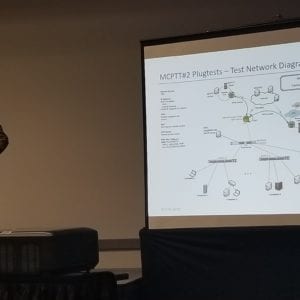LAS VEGAS — What does it take to host an ETSI plugtest event? A whole lot of bandwidth — literally and figuratively — months of planning, and a trio of adorable puppy mascots.
During a session at the International Wireless Communications Expo, Walt Magnussen, director of Texas A&M University’s Internet2 Technology Evaluation Center at TAMU’s Disaster City training facility in College Station, Texas, gave an insider’s perspective on hosting the most recent mission-critical push-to-talk plugtest event. The week-long event last summer was the second MCPTT plugtest event, and the first to test mission-critical data and video along with voice — as well as the first public safety plugtest event from ETSI that was held outside of Europe.
The first plugtest event, held at ETSI headquarters in Sophia Antipolis, France, in the summer of 2017, involved 19 vendors and 47 test cases, with more than 900 tests performed. The second plugtest event brought together 31 vendors, 120 on-site participants and more than 2,100 tests (based on LTE Release 14) run over the course of five days.
“It’s a great environment to watch large companies and small arguably competing and collaborating simultaneously,” said Christopher Walton, an electronics engineer with the Public Safety Communications Research unit at the National Institute for Standards and Technology. NIST’s PSCR was one of a number of organizations which observed the testing.
Magnussen said that two key ingredients contributed to Disaster City’s ability to play host for the plugtest: a large amount of bandwidth, in order to support virtual private networks to each of the participants’ remote assets (which were tested for two months ahead of time to ensure that they would work when everyone was on-site), as well as being a facility where it was relatively easy to bring in a large group of people from all over the world — not necessarily the case at, say, secure federal sites. In addition, he said, having an academic institution as host meant that the organizers could devote a lot of time to making the event a success, even though they weren’t getting paid. You don’t host an ETSI event to get paid, he added — “you want to do it because it’s benefitting industry.”
The success rate for the testing came in at 92% — and the failed tests, as the final report notes, “give the vendors valuable information to improve their implementations. They also help to

discover ambiguities in the standards and to clarify and improve the specifications.”
Plugtest events offer the chance to see the truth of what’s going on at the ground-level in terms of how standards are being implemented.
“You learn there is a lot of ambiguity [in the standard] in some cases,” Magnussen said. “There are options that might go two or three different ways, and you have all these companies that get the standard and read it, and often there’s interpretations.”
Thus, the final report from ETSI includes a list of recommendations to 3GPP to clarify how its mission-critical standards should be implemented.
Despite the long days and the technical challenges — Magnussen warned that the physical set-up time once participants arrive inevitably means trips to purchase more cables and power cords — the event wasn’t without its moments of fun. Magnussen said that his wife breeds Doberman puppies, and three of them who were around at the time were dubbed MCPTT, MCData and MCVideo in honor of the three types of mission-critical LTE features being tested.

